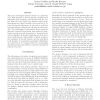944 search results - page 184 / 189 » Spline-Based Robot Navigation |
106
click to vote
BC
2004
14 years 11 months ago
2004
We show that complex visual tasks, such as position- and size-invariant shape recognition and navigation in the environment, can be tackled with simple architectures generated by a...
103
click to vote
KI
2002
Springer
14 years 11 months ago
2002
Springer
In the previous two decades, a number of qualitative constraint calculi have been developed, which are used to represent and reason about spatial configurations. A common property...
102
click to vote
CEC
2009
IEEE
15 years 6 months ago
2009
IEEE
— Legged robots show promise for complex mobility tasks, such as navigating rough terrain, but the design of their control software is both challenging and laborious. Traditional...
113
click to vote
ICRA
2002
IEEE
15 years 4 months ago
2002
IEEE
This paper investigates kinetic behavior of a planetary rover with attention to tire-soil traction mechanics and articulated body dynamics, and thereby study the control when the ...
117
click to vote
ECP
1997
Springer
15 years 3 months ago
1997
Springer
In this paper we describe SINERGY, which is a highly parallelizable, linear planning system that is based on the genetic programming paradigm. Rather than reasoning about the world...


